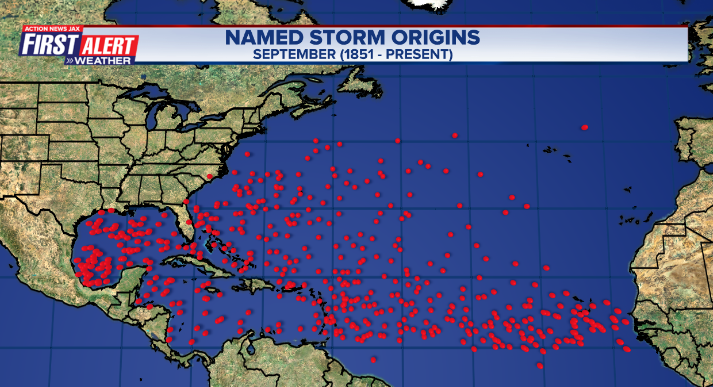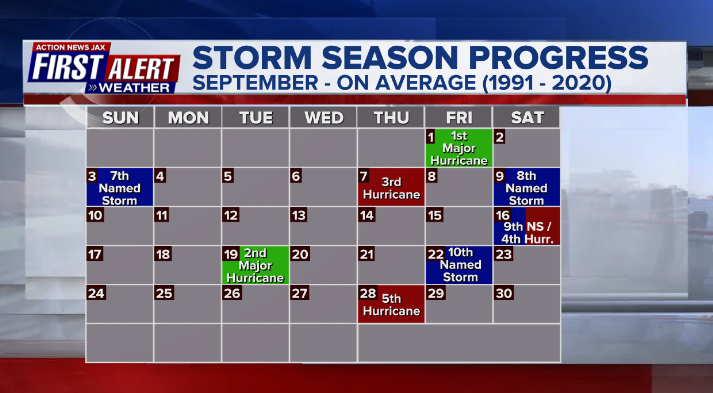Jacksonville, Fl. — The “Buresh Bottom Line”: Always be prepared!.....First Alert Hurricane Preparation Guide... City of Jacksonville Preparedness Guide... Georgia Hurricane Guide.
STAY INFORMED: Get the * FREE * First Alert Weather app
FREE NEWS UPDATES, ALERTS: Action News Jax app for Apple | For Android
WATCH “Preparing for the Storm”
WATCH “The Ins & Outs of Hurricane Season”
READ the First Alert Hurricane Center “Survival Guide”
LISTEN & WATCH “Surviving the Storm” - WOKV Radio & Action News Jax
***** ALWAYS CHECK & RE-CHECK THE LATEST FORECAST & UPDATES! *****
REMEMBER WHEN A TROPICAL STORM OR HURRICANE IS APPROACHING: Taping windows is *not* recommended & will not keep glass from breaking. Instead close curtains & blinds.
Realize the forecast cone (”cone of uncertainty”) is the average forecast error over a given time - out to 5 days - & *does not* indicate the width of the storm &/or where damage that might occur.
*** LOCAL (Jacksonville/NE Fl./SE Ga.) IMPACTS FROM THE TROPICS: None. We will continue to have rough seas & surf through the weekend due to strong onshore flow causing some minor to moderate flooding at times of high tide along the coast, intracoastal, St. Johns River & its tributaries.
The Atlantic Basin Overview:
** Tropical depression #17 formed over the Eastern Atlantic last Sat. morning & was upgraded to tropical storm “Philippe” late in the afternoon...
** A strong tropical wave at a lower latitude & just to the southeast of Philippe has been upgraded to tropical storm “Rina”, the 18th named Atlantic storm of the season...
** A trough of low pressure is off the east coast of Fl. enhancing onshore flow but any significant surface low development appears unlikely at this time.

(1) A strong tropical wave - ‘90-L’ was upgraded to tropical depression #17 midday Saturday over the Eastern Atlantic then to tropical storm “Philippe”, the 16th named storm of the busy ‘23 hurricane season. Philippe is struggling against strong shear out of the west & southwest + some dry air. It now appears Philippe will be weak enough to eventually be steered by the low level trade winds turning the system a bit west, even southwest by through the weekend but only very slowly. It now looks like Philippe will stay east of the Caribbean through at least the weekend with few significant direct impacts for the islands.
Philippe’s poorly defined center will likely jump around some as convection waxes & wanes. Forecast models are struggling with the movement & intensity of Philippe as well as possible interaction with Rina just to the southeast. With the two tropical cyclones only about 500 miles apart, some of the forecast models shows a binary interaction which seems pretty likely given their close proximity. In such situations, one usually “wins out” becoming the dominant one while the weaker one either becomes absorbed by the stronger storm or simply dissipates. Models have ping-ponged on how that might occur but have recently trended toward Philippe becoming the more dominant one. Next week, Philippe *appears* to enter a more favorable area for intensification northeast of the Caribbean... as long as Philippe survives the short term harsh environment.
Once this is sorted out, there should be a rather sharp move to the north over the Central Atlantic during the early to middle part of next week.





(2) A strong tropical wave - ‘91-L’ has come off the coast of Africa over the weekend has been upgraded to tropical cyclone - “Rina” Thu. morning. As the 18th named storm of the season, 2023 now only ranks behind 2020 & the 2021 as the most named Atlantic storms through Sept. 28th. Rina should move northwest over the open Atlantic through the middle of next week. As mentioned in the discussion about Philippe above, there’s at least some interaction between the two tropical cyclones. It appears now that Rina might be the weaker storm though exactly how this scenario plays out is far from certain at this point. There certainly is a good deal of shear affecting Rina at the moment which should limit any significant intensification, at least in the short term.



Check out the upper oceanic heat content (UOHC) [tropical cyclone heat potential/TCHP] across the SW Atlantic, Gulf & Caribbean. The warmth is very deep. But keep in mind warm ocean temps. alone doesn’t necessarily equate to a “big” hurricane season (need other ingredients & factors to be favorable too) but it’s obvious there is a lot of very warm water at great depths over the Caribbean & Gulf of Mexico stretching eastward all the way into the Central Atlantic:




Water vapor loop (dark blue/yellow is dry mid & upper level air):


July tropical cyclone origins:
Averages below based on climatology for the Atlantic Basin for August:

Wind shear:




Saharan dust spreads west each year from Africa by the prevailing winds (from east to west over the Atlantic). Dry air - yellow/orange/red/pink. Widespread dust is indicative of dry air that can impede the development of tropical cyclones. However, sometimes “wanna’ be” waves will just wait until they get to the other side of - or away from - the plume then try to develop if other conditions are favorable. In my personal opinion, way too much is made about the presence of Saharan dust & how it relates to tropical cyclones. In any case, the peak of Saharan dust typically is in June & July.

2023 names..... “Sean” is the next name on the Atlantic list (names are picked at random by the World Meteorological Organization... repeat every 6 years). Historic storms are retired [Florence & Michael in ’18... Dorian in ’19 & Laura, Eta & Iota in ‘20, Ida in ‘21 & Fiona & Ian in ‘22]). In fact, this year’s list of names is rather infamous with “Katrina”, “Rita” & “Wilma” retired from the ‘05 list & “Harvey”, “Irma”,“Maria” & “Nate” from the ‘17 list. The WMO decided - beginning in 2021 - that the Greek alphabet will be no longer used & instead there will be a supplemental list of names if the first list is exhausted (has only happened three times - 2005, 2020 & 2021). The naming of tropical cyclones began on a consistent basis in 1953. More on the history of naming tropical cyclones * here *.





East Atlantic:





Mid & upper level wind shear (enemy of tropical cyclones) analysis (CIMMS). The red lines indicate strong shear:
Water vapor imagery (dark blue indicates dry air):

Deep oceanic heat content over the Gulf, Caribbean & deep tropical Atlantic. The brighter colors are expanding dramatically as we near the peak of the hurricane season.:

Sea surface temp. anomalies:


SE U.S. surface map:

Surface analysis centered on the tropical Atlantic:

Surface analysis of the Gulf:

Caribbean:

Atlantic Basin wave period forecast for 24, 48, 72 & 96 hours respectively:




East/Central Pacific:





West Pacific:

Global tropical activity:



Cox Media Group
:quality(70)/cloudfront-us-east-1.images.arcpublishing.com/cmg/JIFG55NSN5HKZK6LKEZ4C7UU5I.jpg)



:quality(70)/cloudfront-us-east-1.images.arcpublishing.com/cmg/YFVQFPSEYFGUJNN5FIL45PWXNM.jpg)
:quality(70)/cloudfront-us-east-1.images.arcpublishing.com/cmg/GUKNEPXKO4TU3TGUXRFOFQBQLY.jpg)
:quality(70)/d1hfln2sfez66z.cloudfront.net/07-26-2024/t_c813fb310b044b9a937ea03a38306cf5_name_file_960x540_1200_v3_1_.jpg)
:quality(70)/cloudfront-us-east-1.images.arcpublishing.com/cmg/OP4L4IUHEIWRTTX257DKOM4IMU.jpg)
:quality(70)/d1hfln2sfez66z.cloudfront.net/07-24-2024/t_f1680e195e6e40ecbe5b78cf455c5d77_name_file_960x540_1200_v3_1_.jpg)